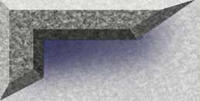Radiographic Features:-
Intra Oral Peri Apical Radiographs i.e. IOPAs are common radiographs which are used as diagnostic aid from
radiological point of view.
Radiographically , Radicular Cysts are round or ovoid radiolucent areas surrounded by a narrow radio-opaque
margin, which extends from Lamina Dura of involved tooth. In infected or rapidly
enlarging cysts, radio-opaque margins may not be seen. Root resorption is rare but may occur.
It is often difficult to differentiate radiologically between radicular cysts & apical granulomas.
Radiologic presentation of Radicular Cyst is given in detail as follows ---
Periphery & Shape--- Periphery usually have a well defined cortical border. If Cyst
is secondarily infected, the inflammatory reaction of surrounding bone may result in loss of this cortex or alteration of
cortex into more sclerotic border. The outline of radicular cyst usually is curved or circular unless it is influenced by
surrounding structures such as cortical boundaries.
Internal structure--- in most cases, internal
structure of radicular cyst is radiolucent. Occasionally, dystrophic calcification may develop in long standing cysts appearing
as sparsely distributed, small particulate radio-opacities.
Effects on surrounding structures---
If a radicular cyst is large, displacement and resorption of roots of
adjacent teeth may occur. The resorption pattern may have a curved outline. In rare cases, the cyst may resorb the roots of
related non-vital teeth. The cyst may invaginate the antrum, but there should be evidence of a cortical boundary between contents
of cyst and internal structure of antrum. The outer cortical plates of maxilla and mandible may expand in a curved or circular
shape. Cyst may displace the mandibular alveolar nerve canal in an inferior direction.

